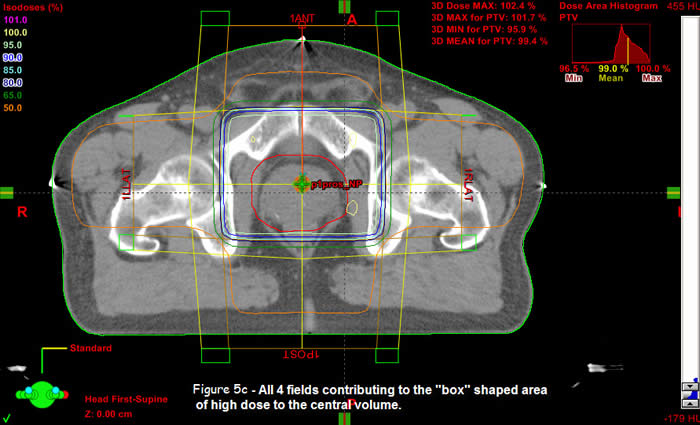RT Beam Basics
Beam Arrangement (single vs multiple beams)
As each patient has distinct curvatures in many planes and body structures with different densities, each radiation field will be distributed differently within the body.
When we use more than one beam, a dose distribution is created in the body as these beams combine. The resulting distribution will have a shape that is different from the initial flat, symmetric beam.
One or all aspects of this resulting dose profile may not be acceptable or satisfactory from a treatment perspective.
One of the main goals of radiation treatment planning is to arrange the radiation beams to cover the Planning Target Volume (PTV) with between 95% and 107% of the prescribed dose. The beams are arranged to accomplish this.
In order to understand how the radiation is going to be distributed within the body, we model radiation fields on the 3 dimension image model which is generated from the planning CT scan.
To understand why and when we would use a single beam or more than one beam, let’s look at the same patient with a variety of beam arrangements.
In figure 5a, with one beam, you can see that the field looks much like our single field on a phantom.
Changes to the beam profile are due to:
- Changes in the body contour so that there is more or less tissue for the beam to go through as the body contour changes in relation to the perpendicular beam entry.
- Changes in the density of structures inside the patient. As the beam passes through the tissues, it will be attenuated more by the dense structures such as bone and less by air cavities such as the lungs or sinuses.
Figure 5a

Two beams combined in a so-called parallel opposed pair (POP) arrangement leads to areas of high dose at the surface with fairly even dose through the middle of the volume.
The areas of high dose nearer the surface are due to the addition of the maximum dose distributed at dmax by one beam and the exit dose of the other beam.
The main point of using a POP beam arrangement is to assure coverage of a volume inside a person in a simple, quick manner. A POP beam arrangement is rarely able to adequately conform the radiation dose profile to a deep seated tumor. In order to do that we need to add more beams.
Figure 5b

With a combination of 4 fields (essentially 2 POP’s), the resulting distribution results in a high dose region “box” in the middle of the patient. This arrangement is therefore called a 4 field box and you can see that it would be useful for tumors in the middle of a patient.
Figure 5c: A four field "box"

The other item to note with the use of the 4 field box is the amount of dose away from the central “box” dose.
Along the path of the beam, from the “box” to the skin surface, the dose is in the 50 – 65% range. With this technique, we are able to deliver 95 - 100% of our prescribed dose to the central area while limiting the amount of dose to the normal tissue along the path of entry of the beam.
You can see how this would be advantageous especially as we increase the dose that is used for therapeutic treatment. Often, the 50% isodose line (defined as the geometric penumbra) is the standard for delineating the effective area of the beam.

